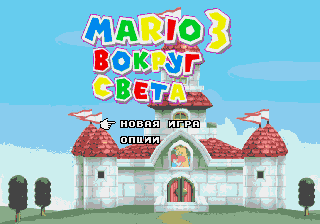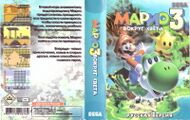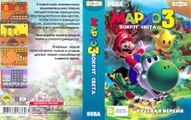Difference between revisions of "Mario 3: Vokrug Sveta"
From Sega Retro
m (Text replacement - "Omni}}" to "Omni}} {{Mario}}") |
|||
| (5 intermediate revisions by 3 users not shown) | |||
| Line 9: | Line 9: | ||
| genre=Action | | genre=Action | ||
| releases={{releasesMD | | releases={{releasesMD | ||
| − | | md_date_ru= | + | | md_date_ru=2011? |
| md_code_ru= | | md_code_ru= | ||
}} | }} | ||
}} | }} | ||
| − | '''''{{PAGENAME}}''''' (Mario 3: Вокруг света) is an unlicensed game developed by [[BMB]] for the [[Sega Mega Drive]]. It is a Mario-based game that uses artwork and music from a variety of sources, such as ''Super Mario All-Stars''. A sequel with most of the same assets, ''[[Mario 4: | + | '''''{{PAGENAME}}''''' (Mario 3: Вокруг света), also known as '''''Mario 3: Around the World''''', is an unlicensed game developed by [[BMB]] for the [[Sega Mega Drive]]. It is a ''Mario''-based game that uses artwork and music from a variety of sources, such as ''Super Mario All-Stars''. A sequel with most of the same assets, ''[[Mario 4: Kosmicheskaya Odisseya]]'', was later released. |
==Story== | ==Story== | ||
| Line 20: | Line 20: | ||
==Gameplay== | ==Gameplay== | ||
[[Image:Mario3AroundTheWorld MD EgyptWorld.png|thumb|right|200px|Gameplay screenshot.]] | [[Image:Mario3AroundTheWorld MD EgyptWorld.png|thumb|right|200px|Gameplay screenshot.]] | ||
| − | Although this is a Mario-based game, the gameplay only has the bare minimum for a Mario game, the physics are awkward and somewhat lacking, and the hit detection is very wonky. The {{A}} button is used to run, and {{B}} is used to jump; however, throwing fireballs is mapped to {{C}} instead of sharing the same button as running. The only power-ups available to Mario are Super Mushrooms and Fire Flowers, and extra lives are gained by collecting 100 coins. The way jumping works is strange compared to official games; while holding {{B}} increases Mario's jump as expected, letting go makes him drop immediately at a faster speed. Mario also has no real friction when he stops walking or running; instead, he'll keep walking/running if he's been moving for long distances or come to a complete stop if he has moved a short distance. | + | Although this is a ''Mario''-based game, the gameplay only has the bare minimum for a ''Mario'' game, the physics are awkward and somewhat lacking, and the hit detection is very wonky. The {{A}} button is used to run, and {{B}} is used to jump; however, throwing fireballs is mapped to {{C}} instead of sharing the same button as running. The only power-ups available to Mario are Super Mushrooms and Fire Flowers, and extra lives are gained by collecting 100 coins. The way jumping works is strange compared to official games; while holding {{B}} increases Mario's jump as expected, letting go makes him drop immediately at a faster speed. Mario also has no real friction when he stops walking or running; instead, he'll keep walking/running if he's been moving for long distances or come to a complete stop if he has moved a short distance. |
The game has a total of 22 levels; 11 Egyptian-themed levels, 6 Aztec-themed levels and 5 arctic-themed levels. Some of the pipes can even take the player to underground areas that skip parts of levels. The usual enemies are encountered throughout the game, such as Goombas, Koopa Troopas and Piranha Plants, as well as Flurries from ''Super Mario Bros. 2'', Pile Driver Micro-Goombas that remain stationary rather than jumping, and Nipper Plants that behave like regular Piranha Plants. | The game has a total of 22 levels; 11 Egyptian-themed levels, 6 Aztec-themed levels and 5 arctic-themed levels. Some of the pipes can even take the player to underground areas that skip parts of levels. The usual enemies are encountered throughout the game, such as Goombas, Koopa Troopas and Piranha Plants, as well as Flurries from ''Super Mario Bros. 2'', Pile Driver Micro-Goombas that remain stationary rather than jumping, and Nipper Plants that behave like regular Piranha Plants. | ||
| Line 41: | Line 41: | ||
| cart= | | cart= | ||
}} | }} | ||
| + | |||
| + | ==Multi-cart appearances== | ||
| + | {{MulticartList}} | ||
==Technical information== | ==Technical information== | ||
| + | {{mainArticle|{{PAGENAME}}/Technical information}} | ||
===ROM dump status=== | ===ROM dump status=== | ||
{{romtable| | {{romtable| | ||
| − | {{rom|MD|sha1=167f17f3a9d24f5d3ed1fbf7d7310fae53015258|md5=9c0f447146eca3c573e7129b808b635c|crc32=6f630ebd|size=2MB|date=|source=Cartridge (RU)|comments=|quality | + | {{rom|MD|sha1=167f17f3a9d24f5d3ed1fbf7d7310fae53015258|md5=9c0f447146eca3c573e7129b808b635c|crc32=6f630ebd|size=2MB|date=|source=Cartridge (RU)|comments=|quality=}} |
}} | }} | ||
| Line 51: | Line 55: | ||
<references/> | <references/> | ||
| + | {{Mario3VokrugSvetaOmni}} | ||
| + | {{Mario}} | ||
[[Category:Unlicensed Mega Drive games]] | [[Category:Unlicensed Mega Drive games]] | ||
Latest revision as of 16:11, 22 July 2024
| Mario 3: Vokrug Sveta | ||||||||||
|---|---|---|---|---|---|---|---|---|---|---|
| System(s): Sega Mega Drive | ||||||||||
| Publisher: KDS | ||||||||||
| Developer: BMB | ||||||||||
| Sound driver: VGM Music Maker | ||||||||||
| Genre: Action | ||||||||||
| Number of players: 1 | ||||||||||
|
Mario 3: Vokrug Sveta (Mario 3: Вокруг света), also known as Mario 3: Around the World, is an unlicensed game developed by BMB for the Sega Mega Drive. It is a Mario-based game that uses artwork and music from a variety of sources, such as Super Mario All-Stars. A sequel with most of the same assets, Mario 4: Kosmicheskaya Odisseya, was later released.
Contents
Story
The plot of Mario 3: Vokrug Sveta begins with a strange cloud that appears in the sky over the Mushroom Kingdom and kidnaps Princess Peach. Mario learns from the Toads that Wario is behind this phenomenon, so he sets out to rescue the Princess. Despite Wario being responsible, he makes no physical appearance in the game whatsoever.
Gameplay
Although this is a Mario-based game, the gameplay only has the bare minimum for a Mario game, the physics are awkward and somewhat lacking, and the hit detection is very wonky. The ![]() button is used to run, and
button is used to run, and ![]() is used to jump; however, throwing fireballs is mapped to
is used to jump; however, throwing fireballs is mapped to ![]() instead of sharing the same button as running. The only power-ups available to Mario are Super Mushrooms and Fire Flowers, and extra lives are gained by collecting 100 coins. The way jumping works is strange compared to official games; while holding
instead of sharing the same button as running. The only power-ups available to Mario are Super Mushrooms and Fire Flowers, and extra lives are gained by collecting 100 coins. The way jumping works is strange compared to official games; while holding ![]() increases Mario's jump as expected, letting go makes him drop immediately at a faster speed. Mario also has no real friction when he stops walking or running; instead, he'll keep walking/running if he's been moving for long distances or come to a complete stop if he has moved a short distance.
increases Mario's jump as expected, letting go makes him drop immediately at a faster speed. Mario also has no real friction when he stops walking or running; instead, he'll keep walking/running if he's been moving for long distances or come to a complete stop if he has moved a short distance.
The game has a total of 22 levels; 11 Egyptian-themed levels, 6 Aztec-themed levels and 5 arctic-themed levels. Some of the pipes can even take the player to underground areas that skip parts of levels. The usual enemies are encountered throughout the game, such as Goombas, Koopa Troopas and Piranha Plants, as well as Flurries from Super Mario Bros. 2, Pile Driver Micro-Goombas that remain stationary rather than jumping, and Nipper Plants that behave like regular Piranha Plants.
The game is also infamous for stealing graphics and music from various sources, which is a trend seen in other games from the same developer. A lot of sprites are taken from Super Mario All-Stars, though Mario's sprites are taken from Mario & Wario. The artwork seen in the opening sequence, level intermissions, ending and various other screens were taken from various sources and downgraded to comply with the Mega Drive's graphical capabilities. The majority of the music was taken from the modules that are included with Shiru's TFM Music Maker, and two of the tracks appear to be conversions of Amiga tracks. Whenever Mario dies by touching an enemy, the game plays a short sample of a conversion of the first boss battle theme from Chrono Trigger done by Chris Kelly[1]; if he dies by bottomless pit however, a DAC sample of someone screaming plays instead.
The most infamous case of stolen assets is the Continue screen, which shows strange artwork called "DeadMario" created by Bibs that was originally posted on Pxleyes.com.[2] The music tracks that play on the Continue and Game Over screens are both taken from UWOL: Quest for Money, which Shiru had composed music for.
Physical scans
Multi-cart appearances
Technical information
- Main article: Mario 3: Vokrug Sveta/Technical information.
ROM dump status
| System | Hash | Size | Build Date | Source | Comments | |||||||||
|---|---|---|---|---|---|---|---|---|---|---|---|---|---|---|
| ? |
|
2MB | Cartridge (RU) |
References
- ↑ https://www.youtube.com/watch?v=7i5srYYVg7c
- ↑ http://www.pxleyes.com/photoshop-picture/4d95917fb69ee/DeadMario.html (Wayback Machine: 2011-04-04 23:32)
Template:Mario3VokrugSvetaOmni



